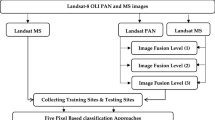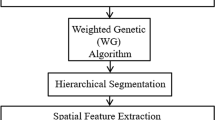Abstract
Hyperspectral images are widely used in many applications. However, finding the appropriate hyperspectral image classification technique is a challenge. In this paper, we propose a new method by using an artificial intelligence-based method for hyperspectral image classification. The system has two parts: first, a pre-processing step, which helps the training phase to work faster; and second, the training part, which consists of calculating the neuro-fuzzy parameters. The prepared system is then applied to the classification of images. Three well-known hyperspectral datasets, including Pavia University from reflective optics system imaging spectrometer, the Botswana image from Hyperion and the Indian Pine image from airborne visible/infrared imaging spectrometer, were chosen to test the method. The final results of the experiments show that this system outperforms two classical methods of hyperspectral classification: support vector machine and spectral angle mapper. The comparison of the final results was made using two different metrics: overall accuracy and total disagreement. The proposed method increases the overall accuracy by about 5% for the Pavia University dataset, 2% for the Botswana dataset and 7% for the Indian Pine dataset. The total disagreement was reduced by about 0.01 for the Pavia University, 0.03 for the Botswana and 0.1 for the Indian Pine dataset when the proposed method was applied.









Similar content being viewed by others
References
Aghaee R and Mokhtarzade M 2015 Classification of hyperspectral images using subspace projection feature space; IEEE Geosci. Remote Lett. 12(9) 1803–1807.
Alajlan N, Bazi Y, Melgani F and Yager R R 2012 Fusion of supervised and unsupervised learning for improved classification of hyperspectral images; Inform. Sci. 217 39–55.
Arslan O 2009 A novel confidence estimation method for neural networks in multispectral image classification; Int. J. Dig. Earth 2(4) 343–358.
Benítez J M, Castro J L and Requena I 1997 Are artificial neural networks black boxes?; IEEE Trans. Neural Netw. 8(5) 1156–1164.
Bilgin G, Erturk S and Yildirim T 2008 Unsupervised classification of hyperspectral-image data using fuzzy approaches that spatially exploit membership relations; IEEE Geosci. Remote Lett. 5(4) 673–677.
Bishop C M 2006 Pattern recognition and machine learning; Springer, New York.
Borasca B, Bruzzone L, Carlin L and Zusi M 2006 A fuzzy-input fuzzy-output SVM technique for classification of hyperspectral remote sensing images; In: Proceedings of the 7th Nordic Signal processing symposium, NORSIG 2006, pp. 2–5.
Braspenning P J and Thuijsman F 1995 Artificial neural network, an introduction to ANN theory and practice; Springer, Berlin.
Chi H-M and Ersoy O K 2005 A statistical self-organizing learning system for remote sensing classification; IEEE Trans. Geosci. Remote 43(8) 1890–1900.
Dennison P E and Roberts D A 2003 Endmember selection for multiple endmember spectral mixture analysis using endmember average RMSE; Remote Sens. Environ. 87(2) 123–135.
Dennison P E, Halligan K Q and Roberts D A 2004 A comparison of error metrics and constraints for multiple endmember spectral mixture analysis and spectral angle mapper; Remote Sens. Environ. 93(3) 359–367.
Franke J, Roberts D A, Halligan K and Menz G 2009 Hierarchical multiple endmember spectral mixture analysis (MESMA) of hyperspectral imagery for urban environments; Remote Sens. Environ. 113(8) 1712–1723.
Hughes G 1968 On the mean accuracy of statistical pattern recognizers; IEEE Trans. Inform. Theory 14(1) 55–63.
Jimenez L O, Morales-Morell A and Creus A 1999 Classification of hyperdimensional data based on feature and decision fusion approaches using projection pursuit, majority voting, and neural networks; IEEE Geosci. Remote Lett. 37(3) 1360–1366.
Jolliffe I 2002 Principal component analysis; John Wiley and Sons, Ltd.
Kohonen T 1990 The self-organizing map; Proc. IEEE 78(9) 1464–1480.
Kumar T, Prasad R, Choudhary A, Mishra V N, Gupta D K and Srivastava P K 2016 A statistical significance of differences in classification accuracy of crop types using different classification algorithms; Geocarto Int. 32(2) 206–224.
Kuo B-C, Huang W-C, Liu H-C and Tseng S-C 2008 A novel fuzzy c-means method for hyperspectral image classification; In: Geoscience and remote sensing symposium 2008, IGARSS 2008, IEEE International 2, II-1002.
Mehrotro K, Mohan C K and Ranka S 2000 Elements of artificial neural networks (2nd edn), MIT Press, Cambridge.
Mojaradi B, Abrishami-Moghaddam H, Zoej M J V and Duin R P 2009 Dimensionality reduction of hyperspectral data via spectral feature extraction; IEEE Trans. Geosci. Remote 47(7) 2091–2105.
Nauck D, Klawonn F and Kruse R 1997 Foundations of neuro-fuzzy systems; John Wiley & Sons, Ltd.
Neuenschwander A L, Crawford M M and Ringrose S 2005 Results from the EO-1 experiment – A comparative study of earth observing-1 advanced land imager (ALI) and Landsat ETM + data for land cover mapping in the Okavango delta, Botswana; Int. J. Remote 26(19) 4321–4337.
Nomura T and Miyoshi T 1995 An adaptive rule extraction with the fuzzy self-organizing map and a comparison with other methods; In: Third international symposium on uncertainty modeling and analysis, 1995, and annual conference of the North American Fuzzy Information Processing Society, Proceedings of ISUMA-NAFIPS’95.
Petropoulos G P, Kalivas D P, Georgopoulou I A and Srivastava P K 2015 Urban vegetation cover extraction from hyperspectral imagery and geographic information system spatial analysis techniques: Case of Athens, Greece J. Appl. Remote Sens. 9 096088.
Picón A, Ghita O, Whelan P F and Iriondo P M 2009 Fuzzy spectral and spatial feature integration for classification of nonferrous materials in hyperspectral data; IEEE Trans. Ind. Inform. 5(4) 483–494.
Pontius Jr R G and Millones M 2011 Death to Kappa: Birth of quantity disagreement and allocation disagreement for accuracy assessment; Int. J. Remote 32(15) 4407–4429.
Qiu F 2008 Neuro-fuzzy based analysis of hyperspectral imagery; Photogramm. Eng. Remote Sens. 74(10) 1235–1247.
Qiu F and Jensen J 2004 Opening the black box of neural networks for remote sensing image classification; Int. J. Remote 25(9) 1749–1768.
Ratle F, Camps-Valls G and Weston J 2010 Semisupervised neural networks for efficient hyperspectral image classification; IEEE Trans. Geosci. Remote 48(5) 2271–2282.
Richards J A 2013 Remote sensing digital image analysis (5th edn), Springer, Canberra.
Singh S K, Srivastava P K, Gupta M, Thakur J K and Mukherjee S 2014 Appraisal of land use/land cover of mangrove forest ecosystem using support vector machine; Environ. Earth Sci. 71 2245–2255.
Somers B, Asner G P, Tits L and Coppin P 2011 Endmember variability in spectral mixture analysis: A review; Remote Sens. Environ. 115(7) 1603–1616.
Song C 2005 Spectral mixture analysis for subpixel vegetation fractions in the urban environment: How to incorporate endmember variability?; Remote Sens. Environ. 95(2) 248–263.
Srivastava P K, Han D, Rico-Ramirez M A, Bray M and Islam T 2012 Selection of classification techniques for land use/land cover change investigation; Adv. Space Res. 50 1250–1265.
Su M and Tew C 2000 A self-organizing feature-map-based fuzzy system; In: Proceedings of the IEEE-INNS-ENNS international joint conference on neural networks, IJCNN 2000, pp. 20–25.
Torabi A J, Er M J, Lim B S, Zhai L, Oentaryo R J, Peen G O and Zurada J M 2015 A survey on artificial intelligence-based modeling techniques for high speed milling processes; IEEE Syst. J. 9(3) 1069–1080.
Yamany S M, Farag A A and Hsu S-Y 1999 A fuzzy hyperspectral classifier for automatic target recognition (ATR) systems; Pattern Recogn. Lett. 20(11) 1431–1438.
Zhang J and Foody G 2001 Fully-fuzzy supervised classification of sub-urban land cover from remotely sensed imagery: Statistical and artificial neural network approaches; Int. J. Remote 22(4) 615–628.
Zhang C and Xie Z 2012 Combining object-based texture measures with a neural network for vegetation mapping in the Everglades from hyperspectral imagery; Remote Sens. Environ. 124 310–320.
Author information
Authors and Affiliations
Corresponding author
Additional information
Corresponding editor: Prasanth K Srivastava
Rights and permissions
About this article
Cite this article
Kakhani, N., Mokhtarzade, M. A new neuro-fuzzy-based classification approach for hyperspectral remote sensing images. J Earth Syst Sci 128, 30 (2019). https://doi.org/10.1007/s12040-018-1054-9
Received:
Revised:
Accepted:
Published:
DOI: https://doi.org/10.1007/s12040-018-1054-9




